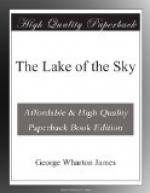It is when sleeping under the lodge pole pines that you begin to appreciate their perfect charm and beauty. You unroll your blankets at the foot of a stately tree at night, unconscious and careless as to what tree it is. During the night, when the moon is at the full, you awaken and look up into a glory of shimmering light. The fine tapering shape, the delicate fairy-like beauty, instantly appeal to the sensitive soul and he feels he is in a veritable temple of beauty.
They are very sensitive trees. In many places a mere grass fire, quick and very fierce for a short time, has destroyed quite a number.
White Fir. This follows closely the range of the incense cedar, though in some places it is found as high as 8700 feet. It is one of the most perfect trees in the Sierras. Ranging from sixty to one hundred and fifty and even two hundred feet high, with a narrow crown composed of flat sprays and a trunk naked for one-third to one-half its height and from one to six feet in diameter, with a smooth bark, silvery or whitish in young trees, becoming thick and heavily fissured into rounded ridges on old trunks, and gray or drab-brown in color, it is readily distinguishable, with its companion, the red fir, by the regularity of construction of trunk, branch and branchlet. As Smeaton Chase expresses it, “The fine smooth arms, set in regular formation, divide and redivide again and again ad infinitum, weaving at last into a maze of exquisitely symmetrical twigs and branchlets.”
Red Fir. The range of the red fir is irregular. It occurs on the Rubicon River and some of the headwaters of the west-flowing streams, reaching a general height of 6000 feet, though it is occasionally found as high as 7000 feet. In some parts of California this is known as Douglas Spruce, and Jepson, in his Silva of California definitely states:
The name “fir” as applied to the species is so well established among woodsmen that for the sake of intelligibility the combination Douglas Fir, which prevents confusion with the true firs and has been adopted by the Pacific Coast Lumberman’s Association, is here accepted, notwithstanding that the name used by botanists, “Douglas Spruce” is actually more fitting on account of the greater number of spruce-like characteristics. It is neither true spruce,




